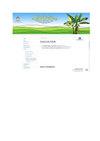槲寄生在南非西北省尼罗海螺上的化学成分和体外干物质降解性
IF 0.3
Q4 AGRONOMY
引用次数: 4
摘要
槲寄生作为反刍动物在不同生长环境中的潜在饲料来源,其营养价值尚缺乏信息。本研究在南非西北省的三个生长点(Lokaleng、Tsetse和Ramatlabama)测定了常见浏览树Vachellia nilotica L.上生长的槲寄生的化学成分和体外干物质降解性(DMD)。研究发现,从三个地点收获的槲寄生的中性洗涤剂纤维、酸性洗涤剂纤维、酸洗涤剂木质素、有机物和粗蛋白含量没有受到地点影响。从Tsetse收获的槲寄生植物的干物质含量(956.1 g/kg)高于来自Lokaleng(927.3 g/kg)和Ramatlabama(855.3 g/kg)的植物。来自Lokaleng的植物的钾含量(112.7g/kg)高于来自Ramatlabama的植物(83.5g/kg)。Tsetse植物的镁和钠含量(分别为5.31 g/kg和0.89 g/kg)低于Lokaleng植物(分别为8.07 g/kg和1.43 g/kg)。Ramatlabama植物的碘含量最高(3.82 g/kg),其次是Lokaleng植物(0.510 g/kg),Tsetse植物的碘水平最低(0.228 g/kg)。来自三个地点的槲寄生植物在2、4、8、12、24、36、48和72小时的体外DMD是相同的(p>0.05)。因此,在该地区,生长位置影响槲寄生植株的化学成分,但不影响槲植物的体外DMD.根据需要,可以向资源贫乏的农民提出特定地点的矿物质补充建议。本文章由计算机程序翻译,如有差异,请以英文原文为准。
Chemical composition and in vitro dry matter degradability of mistletoe Viscum verrucosum Harv on Vachellia nilotica L in North West Province of South Africa
There is a dearth of information on the nutritive value of mistletoe ( Viscum verrucosum (Harv)) as a potential feed source for ruminant animals in different growth environments. This study was conducted to determine the chemical composition and in vitro dry matter degradability (DMD) of mistletoe growing on Vachellia nilotica L., a common browse tree, at three growth sites (Lokaleng, Tsetse and Ramatlabama) in the North West Province of South Africa. The study found no site effects on neutral detergent fibre, acid detergent fibre, acid detergent lignin, organic matter and crude protein contents of mistletoe harvested from the three sites. Mistletoe plants harvested from Tsetse had a higher dry matter content (956.1 g/kg) than plant from Lokaleng (927.3 g/kg) and Ramatlabama (855.3 g/kg). Plants from Lokaleng had a higher potassium content (112.7 g/kg) than those from Ramatlabama (83.5 g/kg). Plants from Tsetse had lower magnesium and sodium (5.31 g/kg and 0.89 g/kg, respectively) contents than those from Lokaleng (8.07 g/kg and 1.43 g/kg, respectively). Plants from Ramatlabama had the highest iodine content (3.82 g/kg), followed by those from Lokaleng (0.510 g/kg) and the lowest levels were found in plants from Tsetse (0.228 g/kg). The in vitro DMD at 2, 4, 8, 12, 24, 36, 48 and 72 hours of mistletoe plants, from the three sites were the same (p > 0.05). Therefore, in this area, growth location influences chemical composition but not in vitro DMD of mistletoe plants, and site-specific recommendations for mineral supplementation can be made to resource-poor farmers as required.
求助全文
通过发布文献求助,成功后即可免费获取论文全文。
去求助
来源期刊

Tropical Agriculture
Social Sciences-Development
CiteScore
0.50
自引率
0.00%
发文量
0
期刊介绍:
The overarching aim of Tropical Agriculture is to contribute to the process of agricultural development in tropical agro-ecosystems, through publication of papers in the area of agricultural science and technology. The specific objectives of the Journal are: -To address the practical aspects of sustainable tropical agriculture production, improvement, protection and commodity utilization, worldwide. -To foster the application of science and technology to understanding and removal of constraints to tropical agricultural productivity. -To publish the results of original research which make significant contributions to knowledge on the practice of sustainable and productive tropical agriculture. The Journal publishes papers in the following areas of tropical agriculture: -Soil Science and Technology -Environmental Science and Technology -Crop Science and Technology -Livestock Science and Technology as well as: Food and Nutrition Policy, Post-Harvest Technology, Agricultural Economics and Extension, Agribusiness
 求助内容:
求助内容: 应助结果提醒方式:
应助结果提醒方式:


